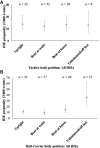A case-control study of tackle based head impact event (HIE) risk factors from the first three seasons of the National Rugby League Women's competition
- PMID: 37334015
- PMCID: PMC10272446
- DOI: 10.3389/fspor.2023.1080356
A case-control study of tackle based head impact event (HIE) risk factors from the first three seasons of the National Rugby League Women's competition
Abstract
Objective: The tackle is the most injurious event in rugby league and carries the greatest risk of concussion. This study aims to replicate previous research conducted in professional men's rugby league by examining the association between selected tackle characteristics and head impact events (HIEs) in women's professional rugby league.
Methods: We reviewed and coded 83 tackles resulting in an HIE and every tackle (6,318 tackles) that did not result in an HIE for three seasons (2018-2020) of the National Rugby League Women's (NRLW) competition. Tackle height, body position of the tackler and ball carrier, as well as the location of head contact with the other player's body were evaluated. Propensity of each situation that caused an HIE was calculated as HIEs per 1,000 tackles.
Results: The propensity for tacklers to sustain an HIE was 6.60 per 1,000 tackles (95% CI: 4.87-8.92), similar to that of the ball carrier (6.13 per 1,000 tackles, 95% CI: 4.48-8.38). The greatest risk of an HIE to either the tackler or ball carrier occurred when head proximity was above the sternum (21.66 per 1,000 tackles, 95% CI: 16.55-28.35). HIEs were most common following impacts between two heads (287.23 HIEs per 1,000 tackles, 95% CI: 196.98-418.84). The lowest propensity for both tackler (2.65 per 1,000 tackles, 95% CI: 0.85-8.20) and ball carrier HIEs (1.77 per 1,000 tackles, 95% CI: 0.44-7.06) occurred when the head was in proximity to the opponent's shoulder and arm. No body position (upright, bent or unbalanced/off feet) was associated with an increased propensity of HIE to either tackler or ball carrier.
Conclusions: In the NRLW competition, tacklers and ball carriers have a similar risk of sustaining an HIE during a tackle, differing from men's NRL players, where tacklers have a higher risk of HIEs. Further studies involving larger samples need to validate these findings. However, our results indicate that injury prevention initiatives in women's rugby league should focus on how the ball carrier engages in contact during the tackle as well as how the tackler executes the tackle.
Keywords: brain concussion; female athlete; head impact events; mild traumatic brain injury; rugby league; tackle.
© 2023 McLeod, Tucker, Edwards, Jones, Page, Spiegelhalter, West, Iverson and Gardner.
Conflict of interest statement
MS is part-funded by Leeds Rhinos rugby league club. RT is a consultant to World Rugby Pty. World Rugby is the governing body for the sport of Rugby Union and responsible for law changes in the sport. BJ is employed by Leeds Rhinos, Rugby Football League and Premiership Rugby in a consultancy capacity. GLI serves as a scientific advisor for NanoDX® Sway Operations, LLC, and Highmark, Inc. He has a clinical and consulting practice in forensic neuropsychology, including expert testimony, involving individuals who have sustained mild TBIs (including former athletes). He has received research funding as a principal investigator from the National Football League, and subcontract grant funding as a collaborator from the Harvard Integrated Program to Protect and Improve the Health of National Football League Players Association Members. He acknowledges unrestricted philanthropic support from ImPACT Applications, Inc., the Mooney-Reed Charitable Foundation, Boston Bolts, the National Rugby League, and the Schoen Adams Research Institute at Spaulding Rehabilitation. None of the above entities were involved in the study design, collection, analysis, interpretation of data, the writing of this article or the decision to submit it for publication. AJG serves as a scientific advisor for HitIQ, Ltd. He has a clinical practice in neuropsychology involving individuals who have sustained sport-related concussion (including current and former athletes). He has been a contracted concussion consultant to Rugby Australia since July 2016. He has received travel funding or been reimbursed by professional sporting bodies, and commercial organisations for discussing or presenting sport-related concussion research at meetings, scientific conferences, workshops, and symposiums. Previous grant funding includes the NSW Sporting Injuries Committee, the Brain Foundation (Australia), an Australian-American Fulbright Commission Postdoctoral Award, a Hunter New England Local Health District, Research, Innovation and Partnerships Health Research & Translation Centre and Clinical Research Fellowship Scheme, and the Hunter Medical Research Institute (HMRI), supported by Jennie Thomas, and the HMRI, supported by Anne Greaves. He has current philanthropic support from the Nick Tooth Foundation. He acknowledges unrestricted philanthropic support from the National Rugby League (NRL). The remaining authors declare that the research was conducted in the absence of any commercial or financial relationships that could be construed as a potential conflict of interest.
Figures
References
-
- Spiegelhalter M, Scantlebury S, Heyward O, Hendricks S, Cummins C, Gardner AJ, et al. The propensity of non-concussive and concussive head contacts during elite-level women's rugby league matches: a prospective analysis of over 14,000 tackle events. J Sci Med Sport. (2023) 26(3):195–201. 10.1016/j.jsams.2023.03.003 - DOI - PubMed
-
- Fuller CW, Taylor A. Women's rugby world cup 2017: summary of results. World Rugby (2017). Available at: https://playerwelfare.worldrugby.org/?documentid=181 (Accessed September 21, 2022).
LinkOut - more resources
Full Text Sources



